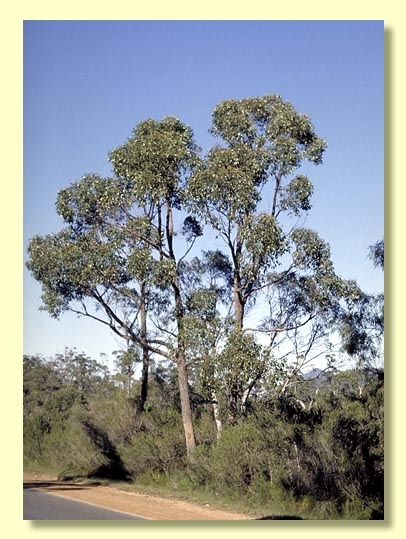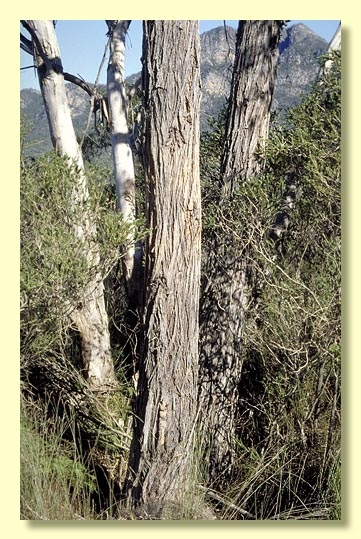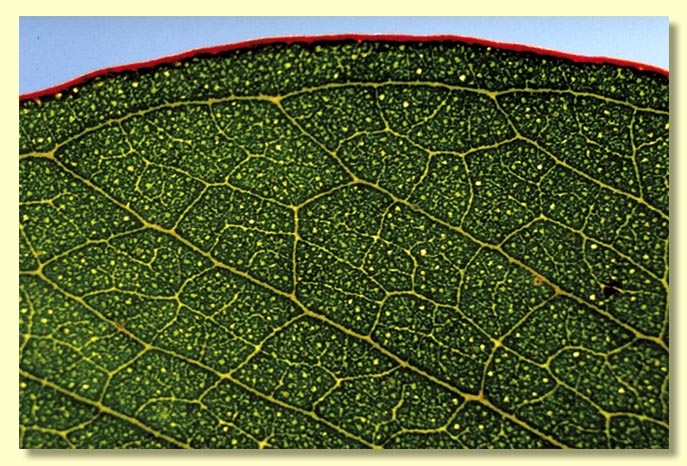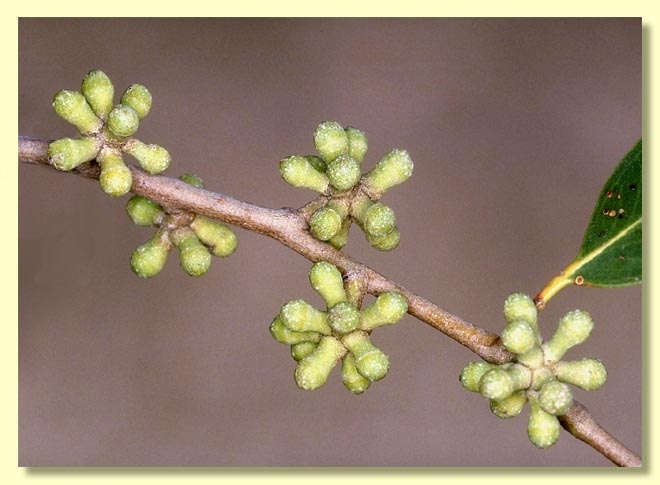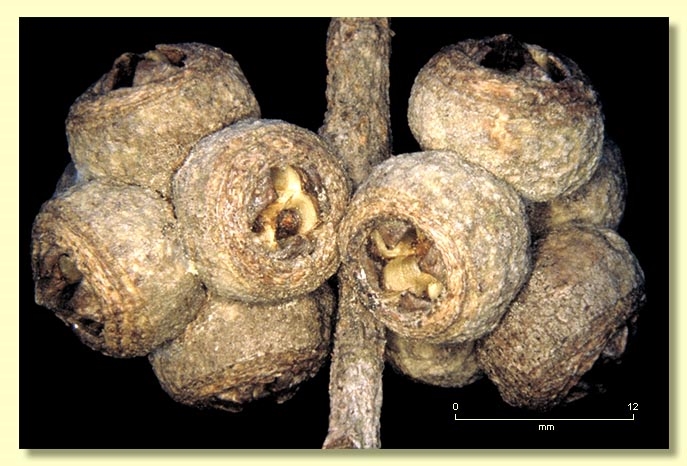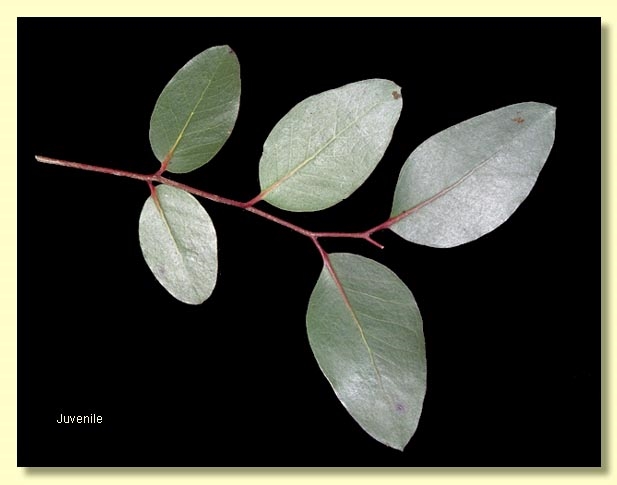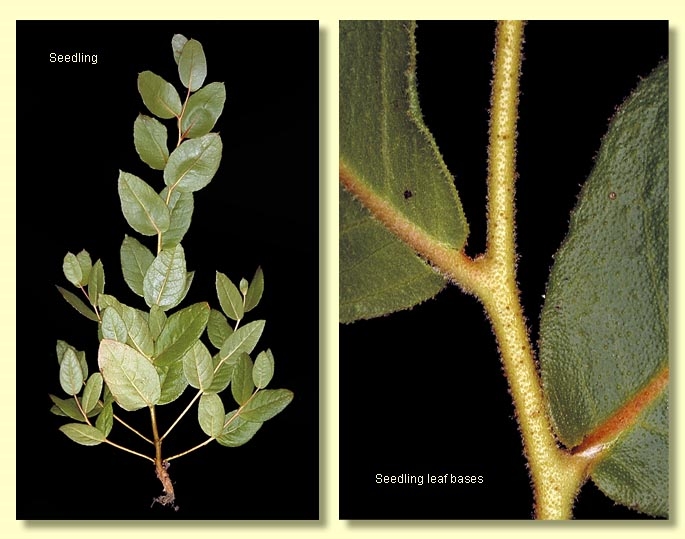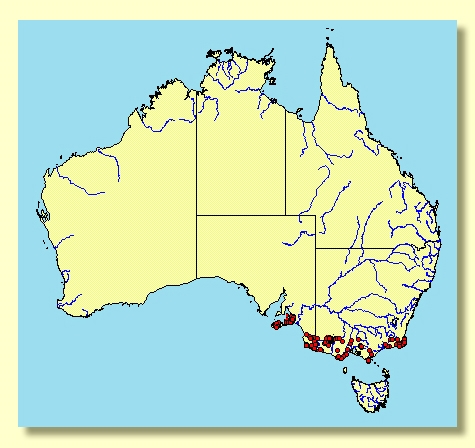Euclid - Online edition
Eucalyptus baxteri
Eucalyptus | Eucalyptus | Capillulus | Pachyphloius
Eucalyptus baxteri (Benth.) Maiden & Blakely ex J.Black, Fl. S. Australia 415 (1926).
E. santalifolia var. (?) baxteri Benth., Fl. Austral. 3: 207 (1867). T: Kangaroo Is., [S.A.], 1828, W.Baxter s.n.; holo: BM; iso: NSW.
E. capitellata var. latifolia Benth., Fl. Austral. 3: 206 (1867). T: near Portland, Vic., J.G.Robertson 503; holo: K, iso: NSW.
E. baxteri var. pedicellata J.M.Black, Fl. S. Australia 3: 416 (1926). Type: "Mt. Lofty Range; 90-Mile Desert from Lameroo to Bordertown and Naracoorte; in the drier localities it is often a small tree or mallee." [note that J.H.Maiden & W.F.Blakely in J.H.Maiden, Crit. Revis. Eucalyptus 7 (1928) 457 state "... the specimen figured at 2c, Plate 38, Ostler's Creek Victoria (A.W. Howitt) may be taken as the type." Ostlers Creek is in East Gippsland Victoria and is montane forested country, not desert, fide A.V.Slee 2019]
Bark rough and stringy to small branches, grey to brown-grey.
Juvenile growth (coppice or field seedlings to 50 cm): stem rounded in cross-section, scabrid at first; juvenile leaves sessile to shortly petiolate and opposite for a few pairs, scabrid above and below with the remains of stellate hairs, becoming alternate, elliptic to ovate and basally oblique, 2.5–10.5 cm long, 1.3–7.5 cm wide, glossy, green, upper leaves glabrous (non-scabrid).
Adult leaves alternate, petiole 1–2.9 cm long; blade lanceolate to falcate or ovate, 6–15 cm long, 1.5–5.5 cm wide, base oblique or tapering to petiole, concolorous, glossy, green, side-veins acute, reticulation usually sparse or obscure, intramarginal vein parallel to and well-removed from margin, with obscure or irregular island oil glands.
Inflorescence axillary unbranched, peduncles stout, 0.2–1.4 cm long, buds in umbels of 9 to 15, sessile or stoutly pedicellate (pedicels to 0.2 cm). Mature buds obovoid to oblong, 0.5–1 cm long, 0.4–0.6 cm wide, green to yellow, warty, scar absent, operculum bluntly conical to rounded or flattened, stamens inflexed or irregularly flexed, anthers reniform to cordate, versatile, dorsifixed, dehiscing by confluent slits (usually), style long, stigma blunt or tapered, locules 3 or 4(5) each with 2 vertical ovule rows. Flowers white.
Fruit sessile or on pedicels to 0.2 cm, cup-shaped, hemispherical or truncate-globose, 0.4–1.2 cm long, 0.7–1.8 cm wide, disc raised and convex or oblique, or disc level, valves 3 or 4(5), exserted or near rim level.
Seeds black or brown, 2–3.5 mm long, pyramidal or obliquely pyramidal, dorsal surface smooth, hilum terminal.
Cultivated seedlings (measured at ca node 10): cotyledons reniform; stems rounded in cross-section, stellate-hairy at least on the lower internodes; leaves opposite, sessile, elliptic to cordate, amplexicaul, discolorous and stellate-hairy for ca 3–9 nodes then becoming shortly petiolate, more ovate and basally oblique, 4–10.5 cm long, 2.5–5.5 cm wide, lamina smooth after alternation, concolorous, glossy, bright green.
Flowering has been recorded in January, June, July, August, September, October, November and December.
A small to medium-sized woodland and forest stringybark tree, occasionally shrubby on coastal dunes and in heath. It occurs on Kangaroo Island, the Mt Lofty Range and lower south-east of South Australia, southern Victoria and the coastal far south-east New South Wales as far north as Pambula Lake. It occurs on coastal plains, low hills and footslopes south of the Great Dividing Range, as well as in the Grampians and Victoria Range. Substrates are poor sandy coastal soils and on undulating subcoastal hills also on nutritionally poor sand over clayey soils.
Eucalyptus baxteri is distinguished by the broadish, thick-textured, green glossy adult leaves, warty buds and large almost globular fruit with a prominent often ascending disc. The related E. arenacea, described in 1988 as a separate species, differs in the lower, usually small tree or mallee habit, smaller leaves, buds and fruit, flatter disc and white sand mallee community habitat. In 2012 a new stringybark tree species, E. aurifodina, closely related to E. baxteri, was described from the Maldon, Carisbrook, Gisborne area. E. aurifodina has strong similarities with E. arenacea sharing the slender peduncles and pedicels and non-warty buds which separate it from E. baxteri. E. victoriana, a related Victorian stringybark species endemic to the Victoria Range west of the Grampians, differs from E. baxteri in having a smooth-barked upper trunk and branches, thick-textured adult leaves and squat, angular buds. E. baxteri was once included in E. capitellata a species of the Sydney area, but this species differs by the buds which have a pointed operculum. A recently described species, E. imitans, from west of Nowra in New South Wales, is also closely related to E. baxteri and the glabrous, ovate-leaved juvenile growth is very reminiscent.
The distribution of Eucalyptus baxteri is more sporadic in the East Gippsland and southern New South Wales part of its range. In these areas it can be either a forest tree of moderate size or a depauperate tree/shrub on coastal dunes, headlands and in heath. In this general area it can be distinguished from other stringybark species by the size and shape of the buds and fruit. The other stringybark species found in this region are: E. muelleriana which has discolorous adult leaves, more globular smooth buds on obvious pedicels, and juvenile leaves that are soon glabrous, E. agglomerata which has fusiform buds and tightly clustered fruit which are lateraly compressed, E. globoidea which has fusiform buds and truncate-globose fruit with a descending disc and included valves, and E. mackintii which has diamond-shaped to ovoid buds slightly angular, and cupular to truncate-globose fruit with more or less level disc.
Throughout the range of E. baxteri another confusing species may be E. obliqua which has similar furrowed stringybark but is not a true stringybark species. E. obliqua differs in the smooth club-shaped buds, more or less barrel-shaped fruit with descending disc and included valves and pendulous green ovate juvenile leaves that are never hairy or scabrid. (All the true stringybarks are classed in Eucalyptus series Capillulus while E. obliqua is in Eucalyptus series Eucalyptus which are the green ash species.)
MORE ABOUT STRINGYBARKS

